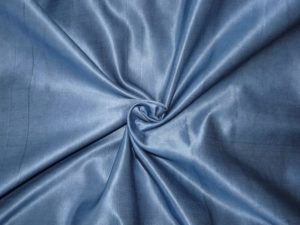 Viscose is an artificial fabric (not to be confused with synthetic), which was first manufactured by Ilie de Chardon in 1884 in France. This material is a product of wood pulp processing. Crushed sawdust of various types of wood is chemically treated and subjected to high pressure and temperature. As a result, threads are formed from the treated substance by pressing through a plate with small holes, and finally these threads are dried. High-quality pure viscose can be confused with silk.
Viscose is an artificial fabric (not to be confused with synthetic), which was first manufactured by Ilie de Chardon in 1884 in France. This material is a product of wood pulp processing. Crushed sawdust of various types of wood is chemically treated and subjected to high pressure and temperature. As a result, threads are formed from the treated substance by pressing through a plate with small holes, and finally these threads are dried. High-quality pure viscose can be confused with silk.
Despite all the positive qualities, viscose material also has negative properties.The fabric wrinkles easily, becomes deformed when washed, and pilling is possible. Viscose tends to wear out when exposed to hot water and ultraviolet rays.
Based on production methods and quality, viscose material is divided into cord fiber, staple fiber and viscose silk. The first is used for high-quality linen, staple fiber is used in insulated clothing, carpets and rugs, and viscose silk is used in home textiles.
Tencel - fabric made from eucalyptus wood. The material resembles cotton in its characteristics and is often used for sewing bed linen, textiles and clothing.
Modal – having almost all the properties of cotton, only more durable, wear-resistant and one and a half times more hygroscopic. It is often combined with cotton fibers to make bed textiles.
Cupra – the most expensive and high-quality viscose material. In appearance and in its properties, cupra is very similar to silk. Needs delicate care. Used for sewing evening dresses and festive outfits.
Acetate – the material is based not on whole cellulose, but on its waste (cellulose acetate). The fabric is thin, has a slight shine, similar to silk. The main distinguishing feature is its resistance to deformation and bruising, but at the same time reduced hygroscopicity and air permeability, as well as instability to high temperatures
Siblon – is the “youngest” viscose material. This viscose was obtained in the second half of the 70s from coniferous trees. All its positive properties are improved by no less than one and a half times than all of the above types of viscose material.
Other materials such as cotton, polyester, elastane can be added to the fabric.The latter is necessary to impart elastic properties to the fabric; it is usually mixed in a ratio of 5% elastane and 95% viscose, which ultimately increases wear resistance and elasticity. By adding polyester, a “butter” fabric is obtained, resulting in a material that is more pleasant to the touch. Products made from polyester fit your body well. Therefore, it is used to create dresses, skirts and women's sportswear. Cotton in combination with viscose gives the fabric greater strength, but just like pure viscose, when it comes into contact with water, its strength decreases by 55%. It should be noted that the fabric is prone to shrinkage.
Viscose is used very widely; it has long penetrated into our everyday life and into many areas of our lives.
Viscose material can be found in almost every home as part of bed linen, clothing (both summer and winter - with fleece lycra), home textiles, as a lining for outerwear, rags and napkins for cleaning. Viscose material is also used in the production of cellophane, car tires, shoes and much more.